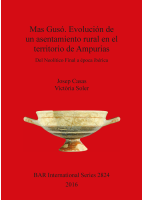Description
Este libro analiza los resultados de las excavaciones en el yacimiento de Mas Gusó, cercano a la antigua colonia focea de Emporion, centrándose en el periodo más antiguo, el cual abarca desde las primeras y pequeñas ocupaciones pertenecientes al Neolítico Final y bronce Inicial, para continuar con el principal y más importante asentamiento agrícola de la primera Edad del Hierro, que, a su vez, dará paso al establecimiento ibérico surgido como consecuencia de la fundación de Emporion. Se analizan con detalle los diferentes ámbitos y estructuras de cada época, así como los distintos restos de la cultura material del yacimiento: cerámica local y de importación, otros instrumentos de la vida cotidiana, así como los restos de fauna más significativos.Abandonado el hábitat ibérico, décadas más tarde surgirá un nuevo complejo de época romana, de carácter público u oficial (una statio), edificado a finales del siglo II aC, el cual será objeto de un próximo estudio monográfico.
The present book analyses the results of the excavation of the settlement of Mas Gusó, located nearby the ancient Phocean colony of Emporion, focusing on the oldest periods, from the first small occupations during the Late Neolithic and Early Bronze Age, to the larger and more relevant farmer settlement during the Early Iron Age, which in turn gave way to the Iberian establishment that arose as a result of the foundation of Emporion. The domains and structures of each period are analysed in detail, as well as the different kinds of material culture remains found at the settlement: local and imported pottery, other tools and utensils of the daily life, as well as the most significant faunal remains. Decades after the decay of the Iberian settlement, a new Roman complex arose, an official public construction (a statio), built during the late second century AD, which will be the object of an upcoming monographical study.
AUTHOR
Josep Casas-Genover es miembro del Laboratorio de Arqueología y Prehistoria de la Universidad de Girona. Desde 1980 ha centrado sus investigaciones en el periodo ibérico y romano en el noreste de Cataluña, dirigiendo excavaciones en yacimientos de diversa índole. Autor y coautor de numerosas publicaciones sobre temas específicos de arqueologia.
Victòria Soler-Fusté ha participado, gestionado y llevado a cabo excavaciones arqueológicas en yacimientos ibéricos y romanos en el N.E. de Cataluña desde 1980. Coautora de numerosas publicaciones especializadas, libros y artículos sobre arqueología, estudios de yacimientos, cerámicas ibéricas y romanas, historia local y patrimonio.
Josep Casas-Genover is a member of the Laboratory of Archaeology and Prehistory (LAP) at the University of Girona. Since 1980, the focus of his research has been the Iberian and Roman periods in north-eastern Catalonia, having led excavations of settlements of a wide-ranging nature. He is also an author and co-author of numerous publications on specific archaeological matters.
Victòria Soler-Fusté has taken part in, managed and carried out numerous archaeological excavations in Iberian and Roman settlements in north-eastern Catalonia since 1980. She is also a co-author of numerous specialized publications, books and papers on archaeology, and studies on settlements, Iberian and Roman pottery, local history and heritage.
REVIEW
'The contribution [made by this work] is very great because the archaeological site of Mas Gusó is exceptional. The book will be a reference for studies on the formation of the Iberian culture and the impact on their settlements caused by Mediterranean people in the archaic period.' Anonymous reviewer
'Brings valuable knowledge about the relationship between pottery design variables and the settlements of different societies that inhabited Mas Gusó site.' Anonymous reviewer
'La monografía sobre Mas Gusó será del máximo interés para los especialistas que trabajan sobre diversos aspectos de los períodos pre y protohistóricos. Es un libro que aporta muchos datos relevantes de la protohistoria de la llanura del Ampurdán.' Dr Joaquim Tremoleda Trilla, Museu d'Arqueologia de Catalunya.











